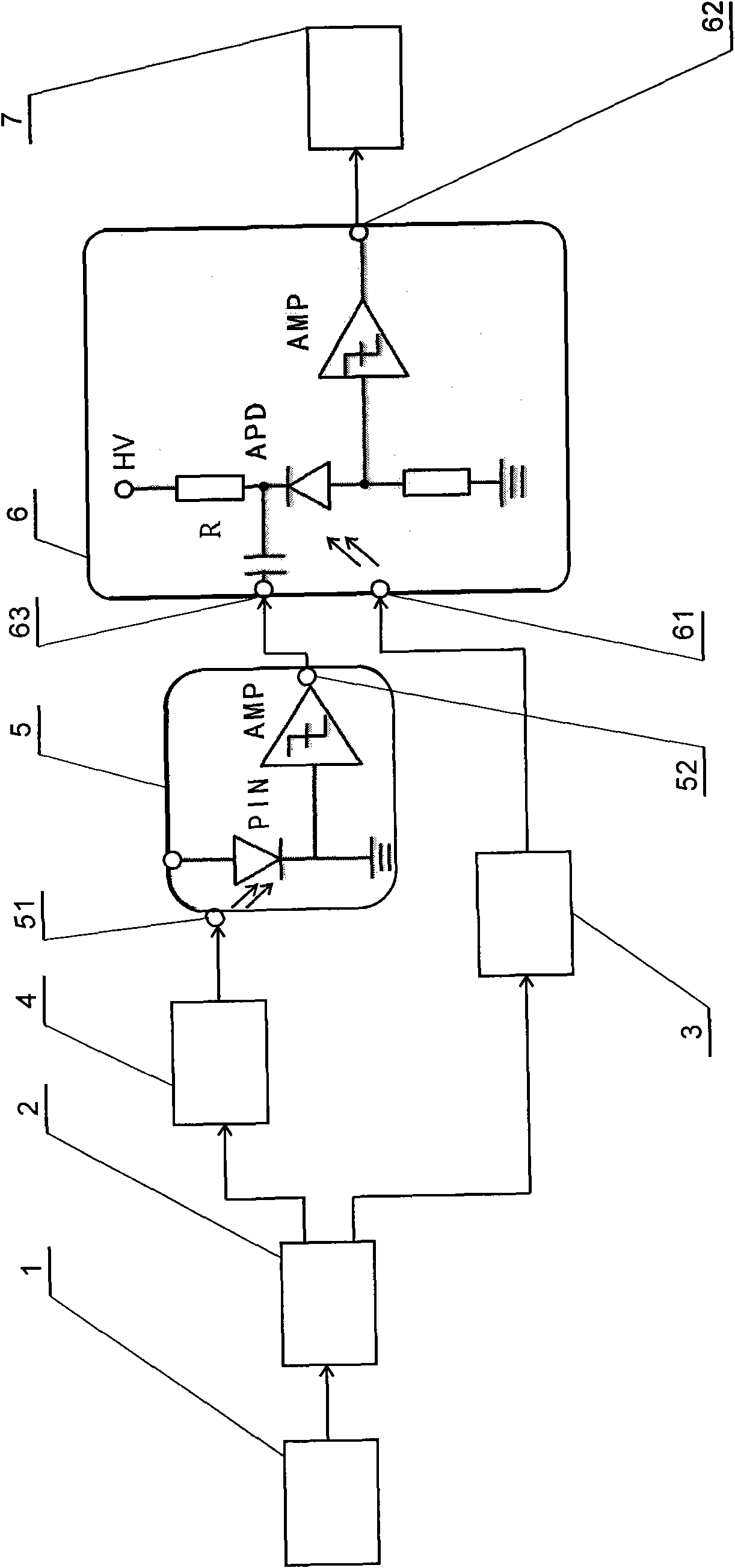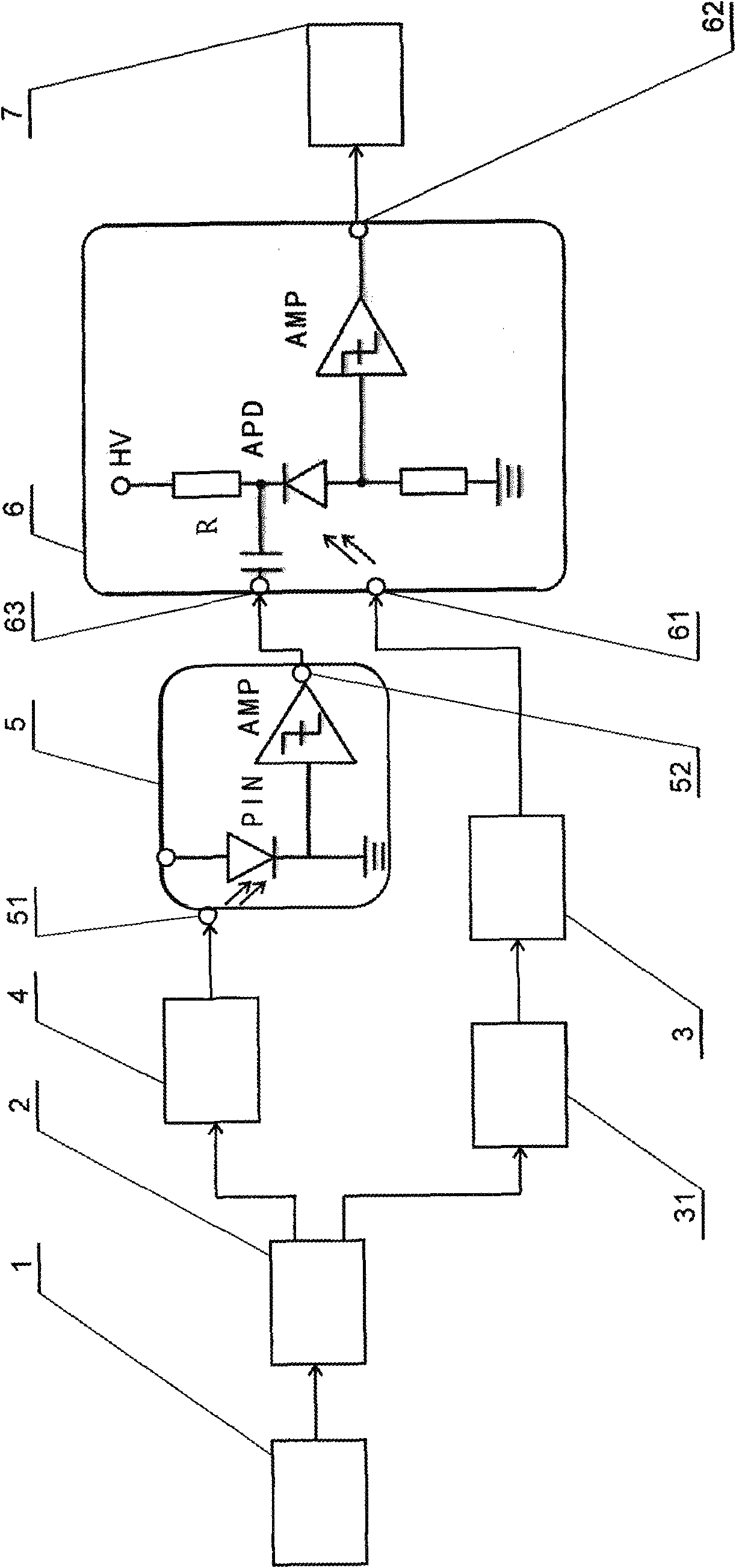High time resolution low noise single photon detector based on optical pulse synchronization
A single-photon detector, high time resolution technology, applied in the direction of instruments, etc., can solve the problems of large post-pulse influence, large time jitter, low signal-to-noise ratio, etc., to improve time resolution, reduce time jitter, and signal synchronization accurate effect
- Summary
- Abstract
- Description
- Claims
- Application Information
AI Technical Summary
Problems solved by technology
Method used
Image
Examples
Embodiment 1
[0018] refer to figure 1 , this embodiment is to load a single Gaussian gate signal to the avalanche diode APD.
[0019] The optical pulse signal sent by the optical pulse generator 1 is divided into two paths by the optical fiber coupler 2, and one path is attenuated by the optical attenuator 3 and then used as incident light by the second optical signal input end 61 of the gate pulse amplification module 6 to enter the avalanche On the diode APD; the other way passes through the optical delay device 4 to control the delay of the optical signal, and the delayed optical signal is incident on the photodiode PIN by the first optical signal input end 51 of the photoelectric conversion module 5, so that it generates a The Gaussian gate pulse electric signal with relatively slow rising and falling edges is amplified by the first amplifier AMP, and the capacitance circuit of the second electric signal input terminal 63 of the gate pulse amplification module 6 and the optical signal ...
Embodiment 2
[0021] refer to figure 2 , this embodiment uses re-excitation light as the incident light.
[0022] The excitation light is generated by the optical pulse signal by re-exciting other substances, such as: emittable light, fluorescent light and scattered light as the incident light, which is incident on the avalanche diode APD from the second optical signal input terminal 61 of the gate pulse amplification module 6. The specific process as follows:
[0023] The optical pulse generator 1 sends out an optical pulse signal, which is divided into two paths by the fiber coupler 2, and one path passes through the luminous body 31 to generate excitation light, and after being attenuated by the optical attenuator 3, it is used as the second light by the gate pulse amplification module 6 as the incident light. The signal input terminal 61 is incident on the avalanche diode APD; the other path passes through the optical delay device 4 to control the delay of the optical signal, and the ...
Embodiment 3
[0025] refer to image 3 In this embodiment, two positive and negative Gaussian gate signals are loaded on the avalanche diode APD at the same time, so that the amplitude of the Gaussian gate pulse can be greatly increased, and the DC high voltage can be reduced and the dark count can be reduced at the same detection efficiency. The specific process is as follows:
[0026]The optical pulse generator 1 sends out optical pulse signals, which are divided into three paths by the optical fiber coupler 2: one path is attenuated by the optical attenuator 3 and then used as incident light by the second optical signal input port 61 of the gate pulse amplification module 6 to enter the avalanche diode On the APD; the other way passes through the optical delay device 4 to control the delay of the optical signal, and the delayed optical signal is incident on the photodiode PIN by the first optical signal input terminal 51 of the photoelectric conversion module 5, so that it generates a ri...
PUM
 Login to View More
Login to View More Abstract
Description
Claims
Application Information
 Login to View More
Login to View More - R&D
- Intellectual Property
- Life Sciences
- Materials
- Tech Scout
- Unparalleled Data Quality
- Higher Quality Content
- 60% Fewer Hallucinations
Browse by: Latest US Patents, China's latest patents, Technical Efficacy Thesaurus, Application Domain, Technology Topic, Popular Technical Reports.
© 2025 PatSnap. All rights reserved.Legal|Privacy policy|Modern Slavery Act Transparency Statement|Sitemap|About US| Contact US: help@patsnap.com



